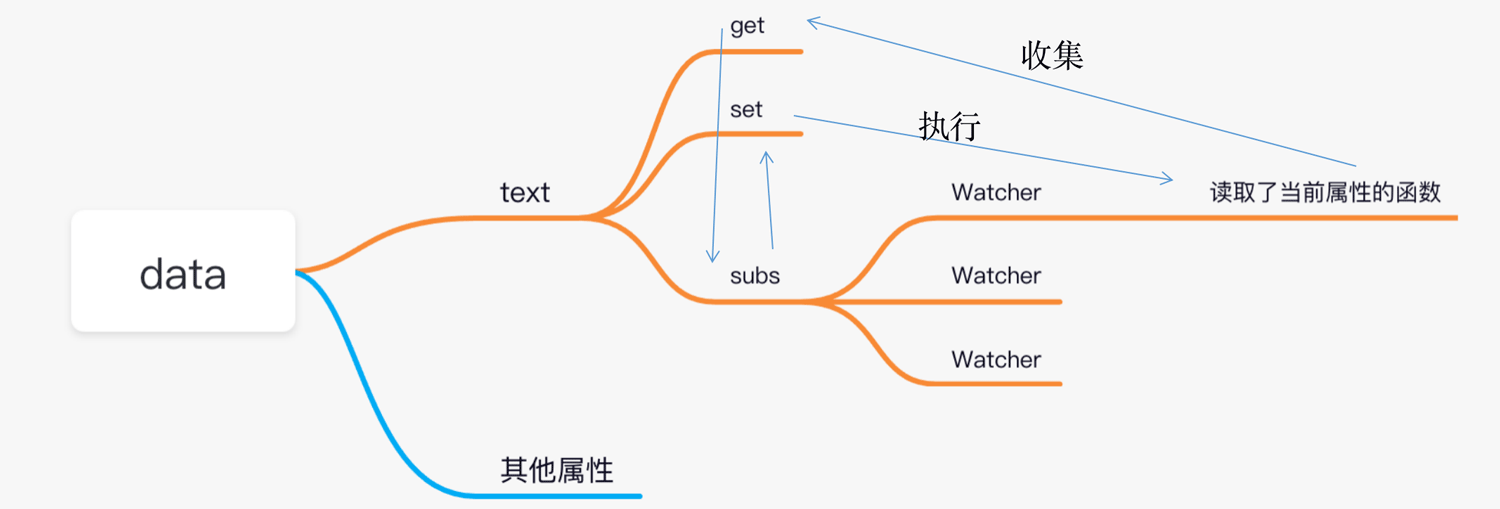前言:
目前工作中大概有 的需求是在用 的技术栈,所谓知其然更要知其所以然,为了更好的使用 、更快的排查问题,最近学习了源码相关的一些知识,虽然网上总结 的很多很多了,不少自己一个,但也不多自己一个,欢迎一起讨论学习,发现问题欢迎指出。40%Vue2VueVue
回到最简单的代码:
data = {
text: 'hello, world'
}
const updateComponent = () => {
console.log('收到', data.text);
}
updateComponent()
data.text = 'hello, liang'
// 运行结果
// 收到 hello, world
响应式系统要做的事情:某个依赖了 数据的函数,当所依赖的 数据改变的时候,该函数要重新执行。datadata
我们期望的效果:当上边 修改的时候, 函数再执行一次。data.textupdateComponent
为了实现响应式系统,我们需要做两件事情:
datadata中的数据改变的时候去调用依赖它的函数们为了实现第 点,我们需要在执行函数的时候,将当前函数保存起来,然后在读取数据的时候将该函数保存到当前数据中。1
第 点就迎刃而解了,当修改数据的时候将保存起来的函数执行一次即可。2
在读取数据和修改数据的时候需要做额外的事情,我们可以通过 重写对象属性的 和 函数。Object.defineProperty()getset
我们来写一个函数,重写属性的 和 函数。getset
/**
* Define a reactive property on an Object.
*/
export function defineReactive(obj, key, val) {
const property = Object.getOwnPropertyDescriptor(obj, key);
// 读取用户可能自己定义了的 get、set
const getter = property && property.get;
const setter = property && property.set;
// val 没有传进来话进行手动赋值
if ((!getter || setter) && arguments.length === 2) {
val = obj[key];
}
Object.defineProperty(obj, key, {
enumerable: true,
configurable: true,
get: function reactiveGetter() {
const value = getter ? getter.call(obj) : val;
/*********************************************/
// 1.这里需要去保存当前在执行的函数
/*********************************************/
return value;
},
set: function reactiveSetter(newVal) {
const value = getter ? getter.call(obj) : val;
if (setter) {
setter.call(obj, newVal);
} else {
val = newVal;
}
/*********************************************/
// 2.将依赖当前数据依赖的函数执行
/*********************************************/
},
});
}
为了调用更方便,我们把第 步和第 步的操作封装一个 类。12Dep
export default class Dep {
static target; //当前在执行的函数
subs; // 依赖的函数
constructor() {
this.subs = []; // 保存所有需要执行的函数
}
addSub(sub) {
this.subs.push(sub);
}
depend() {
// 触发 get 的时候走到这里
if (Dep.target) {
// 委托给 Dep.target 去调用 addSub
Dep.target.addDep(this);
}
}
notify() {
for (let i = 0, l = this.subs.length; i < l; i++) {
this.subs[i].update();
}
}
}
Dep.target = null; // 静态变量,全局唯一
我们将当前执行的函数保存到 类的 变量上。Deptarget
为了保存当前的函数,我们还需要写一个 类,将需要执行的函数传入,保存到 类中的 属性中,然后交由 类负责执行。WatcherWatchergetterWatcher
这样在 类中, 中保存的就不是当前函数了,而是持有当前函数的 对象。DepsubsWatcher
import Dep from "./dep";
export default class Watcher {
constructor(Fn) {
this.getter = Fn;
this.get();
}
/**
* Evaluate the getter, and re-collect dependencies.
*/
get() {
Dep.target = this; // 保存包装了当前正在执行的函数的 Watcher
let value;
try {
// 调用当前传进来的函数,触发对象属性的 get
value = this.getter.call();
} catch (e) {
throw e;
}
return value;
}
/**
* Add a dependency to this directive.
*/
addDep(dep) {
// 触发 get 后会走到这里,收集当前依赖
// 当前正在执行的函数的 Watcher 保存到 dep 中的 subs 中
dep.addSub(this);
}
/**
* Subscriber interface.
* Will be called when a dependency changes.
*/
// 修改对象属性值的时候触发 set,走到这里
update() {
this.run();
}
/**
* Scheduler job interface.
* Will be called by the scheduler.
*/
run() {
this.get();
}
}
Watcher 的作用就是将正在执行的函数通过 包装后保存到 中,然后调用传进来的函数,此时触发对象属性的 函数,会收集当前 。WatcherDep.targetgetWatcher
如果未来修改对象属性的值,会触发对象属性的 ,接着就会调用之前收集到的 对象,通过 对象的 方法,来调用最初执行的函数。setWatcherWatcheruptate
回到我们之前没写完的 函数,按照上边的思路,我们来补全一下。defineReactive
import Dep from "./dep";
/**
* Define a reactive property on an Object.
*/
export function defineReactive(obj, key, val) {
const property = Object.getOwnPropertyDescriptor(obj, key);
// 读取用户可能自己定义了的 get、set
const getter = property && property.get;
const setter = property && property.set;
// val 没有传进来话进行手动赋值
if ((!getter || setter) && arguments.length === 2) {
val = obj[key];
}
/*********************************************/
const dep = new Dep(); // 持有一个 Dep 对象,用来保存所有依赖于该变量的 Watcher
/*********************************************/
Object.defineProperty(obj, key, {
enumerable: true,
configurable: true,
get: function reactiveGetter() {
const value = getter ? getter.call(obj) : val;
/*********************************************/
// 1.这里需要去保存当前在执行的函数
if (Dep.target) {
dep.depend();
}
/*********************************************/
return value;
},
set: function reactiveSetter(newVal) {
const value = getter ? getter.call(obj) : val;
if (setter) {
setter.call(obj, newVal);
} else {
val = newVal;
}
/*********************************************/
// 2.将依赖当前数据依赖的函数执行
dep.notify();
/*********************************************/
},
});
}
我们再写一个 方法,把对象的全部属性都变成响应式的。Observer
export class Observer {
constructor(value) {
this.walk(value);
}
/**
* 遍历对象所有的属性,调用 defineReactive
* 拦截对象属性的 get 和 set 方法
*/
walk(obj) {
const keys = Object.keys(obj);
for (let i = 0; i < keys.length; i++) {
defineReactive(obj, keys[i]);
}
}
}
我们提供一个 方法来负责创建 对象。observeObserver
export function observe(value) {
let ob = new Observer(value);
return ob;
}
将上边的方法引入到文章最开头的例子,来执行一下:
import { observe } from "./reactive";
import Watcher from "./watcher";
const data = {
text: "hello, world",
};
// 将数据变成响应式的
observe(data);
const updateComponent = () => {
console.log("收到", data.text);
};
// 当前函数由 Watcher 进行执行
new Watcher(updateComponent);
data.text = "hello, liang";
此时就会输出两次了~
收到 hello, world
收到 hello, liang
说明我们的响应式系统成功了。

先从整体理解了响应式系统的整个流程:
每个属性有一个 数组, 会持有当前执行的函数,当读取属性的时候触发 ,将当前 保存到 数组中,当属性值修改的时候,再通过 数组中的 对象执行之前保存的函数。subsWatchergetWatchersubssubsWatcher